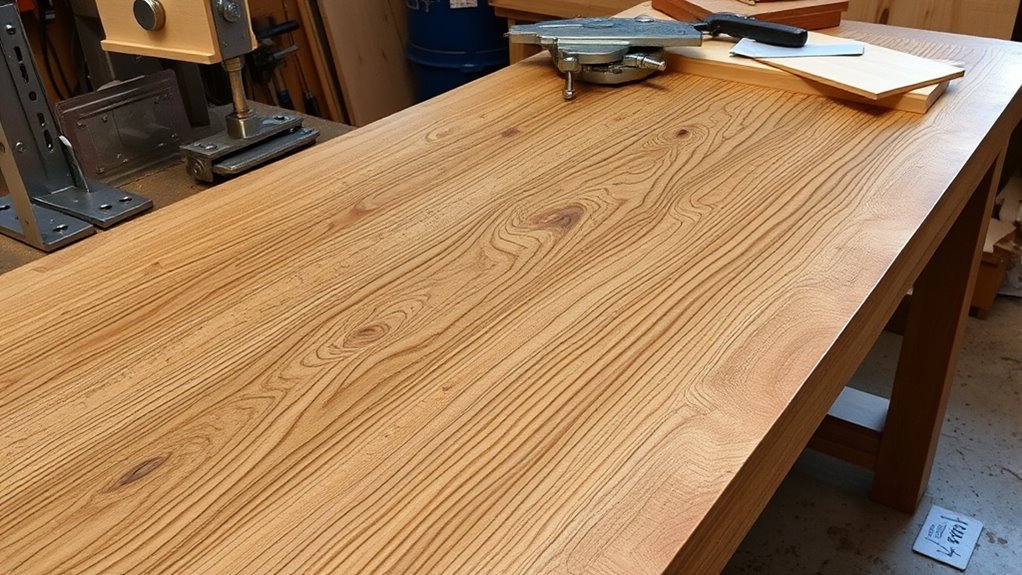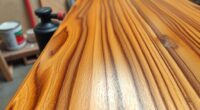By combining metal with woodworking, you can create stronger, more durable, and visually striking projects. Use versatile tools like band saws, hacksaws, and abrasive cutoffs to shape metal, and join materials with adhesives, epoxy, or mechanical fasteners. Incorporate safety measures to handle metal safely, and experiment with different combinations for both function and aesthetics. If you want to explore detailed tools, techniques, and tips for working with metal in your projects, there’s much more to discover.
Key Takeaways
- Use versatile saws and blades designed for both wood and metal to streamline cutting processes.
- Employ appropriate joining methods like epoxy, construction adhesives, or mechanical fasteners for durable metal-wood bonds.
- Prioritize safety by inspecting materials, wearing protective gear, and maintaining tools when working with metal components.
- Select metal types and finishes, such as copper or brass with patina, to enhance aesthetic appeal and project longevity.
- Apply precise techniques like scoring, cold cutting, and surface preparation to ensure clean, accurate integration of materials.
Tools and Equipment Adapted for Metal in Woodworking
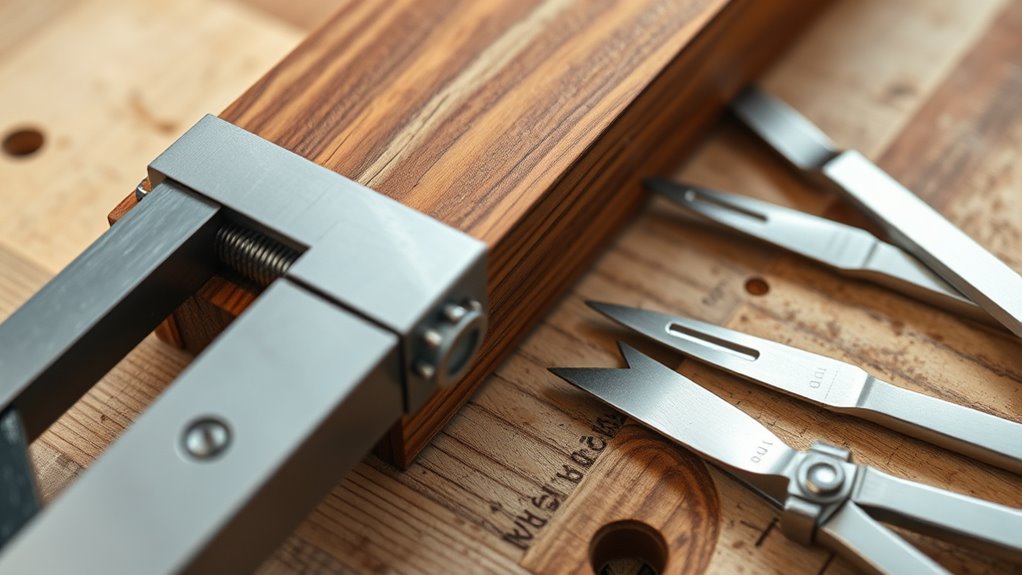
To effectively incorporate metal into woodworking projects, you need tools and equipment adapted to handle both materials. Versatile band saws with adjustable speeds and blade types let you cut wood and metal efficiently. Using proper mindfulness techniques can help maintain focus and safety during complex cutting procedures. Hand hacksaws and bimetal hole saws enable precise cuts of metal components integrated into your designs. Abrasive cutoff and cold saws produce clean metal cuts without damaging nearby wood. Portable metal cutting saws with dust collection keep your workspace clean. Combination saw blades that handle both materials reduce tool changes, boosting efficiency. Material compatibility is essential to ensure seamless integration and durability of the finished piece. Metal forming tools like English wheels, bead rollers, and pipe benders allow shaping metal accents to complement wooden elements. These specialized tools ensure accurate, safe, and seamless integration of metal into your woodworking projects.
Techniques for Cutting and Shaping Metal Components in Woodworking
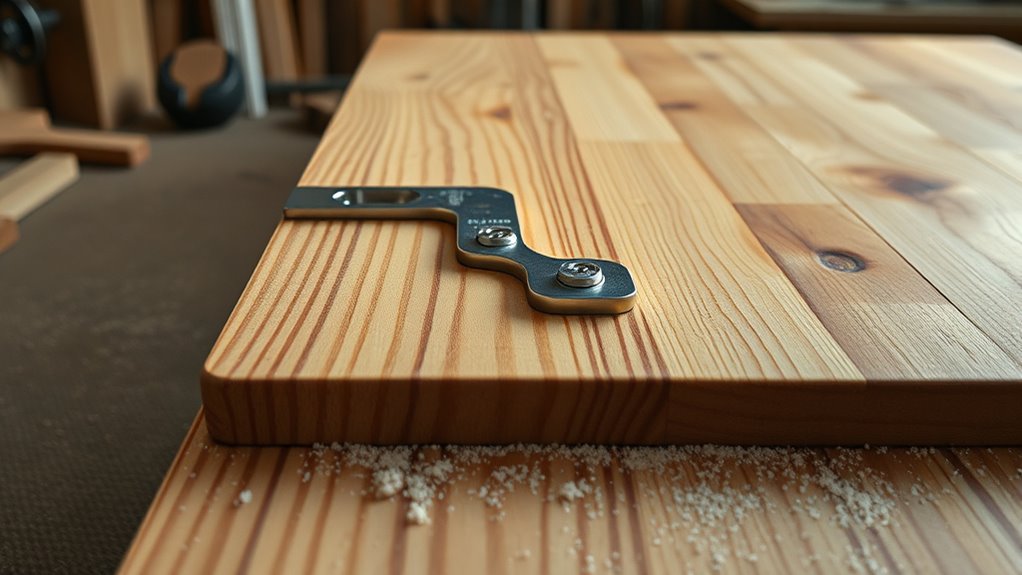
When working with metal components in woodworking, choosing the right cutting and shaping techniques is essential for achieving precise and clean results. Cold cutting uses manual tools like hacksaws, snips, or files to cut metal without heating it. Begin by scoring a groove with gentle strokes to guide your cut, then apply more pressure to fully penetrate. This method works best for thin sheets and small parts. Proper technique and patience are key to avoiding mistakes and ensuring a professional finish. Keep your blades sharp and well-maintained to ensure clean cuts and prevent damage. Always wear safety glasses and gloves to protect against shards. For thicker or tougher metals, hot cutting—heating the metal until malleable—may be necessary. Using the correct metal properties can help determine the best approach for your project, especially when working with more ductile or harder materials. Additionally, understanding material strength can influence your choice of tools and techniques to achieve optimal results. Employing the right welding techniques can also enhance the durability and finish of your metal-wood projects. Proper safety precautions are crucial throughout, and selecting the appropriate cutting tools based on the metal type can significantly improve your efficiency and safety.
Methods for Joining Metal to Wood
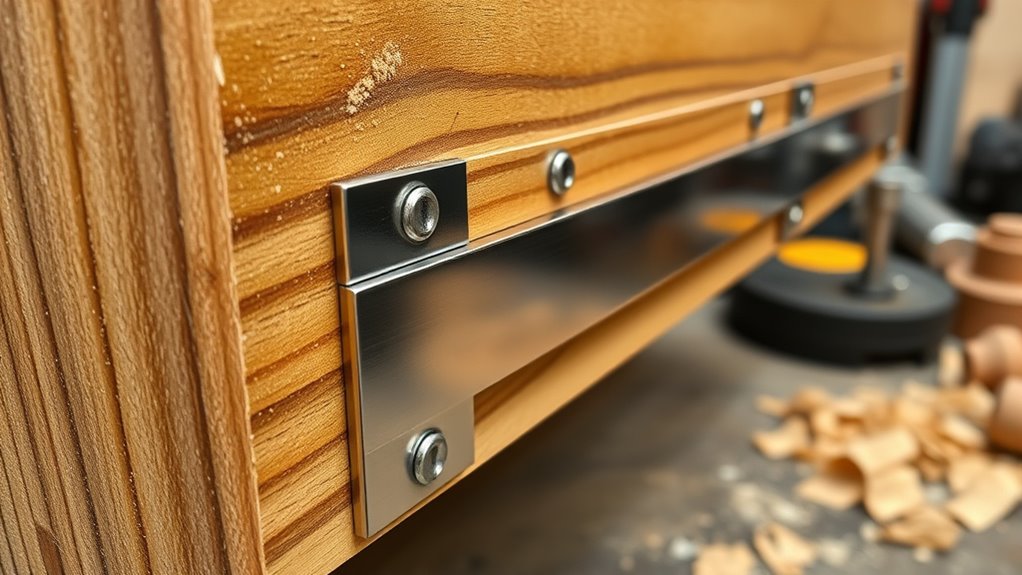
Joining metal to wood requires selecting the right adhesive based on your project’s specific needs. For large surfaces, construction adhesives work well, while super glue suits small repairs. Epoxy is excellent for bonding porous and non-porous materials, filling gaps, and providing strong screw anchoring. High quality epoxy can also help improve overall bond strength and durability in various applications. Using appropriate adhesives ensures a reliable and long-lasting bond suitable for different project requirements. Polyurethane adhesives, like Gorilla Glue, expand during curing, ideal for tight fits and uneven surfaces. Cyanoacrylate (super glue) offers precision bonding for small ornaments or thin metal sheets. Proper surface prep is vital—sand the wood, clean and roughen the metal, and ensure both are dry. Understanding regional legal resources can help you choose the best products for your specific project, especially if your project involves outdoor or load-bearing applications. Knowing adhesive safety guidelines is crucial to ensure proper handling and avoid health risks. Clamping pressure and curing time vary depending on the adhesive, from 30 minutes to 24 hours. For outdoor or load-bearing applications, choose weatherproof and high-strength options, and always verify the bond before completing your project.
Benefits of Combining Metal and Wood in Projects
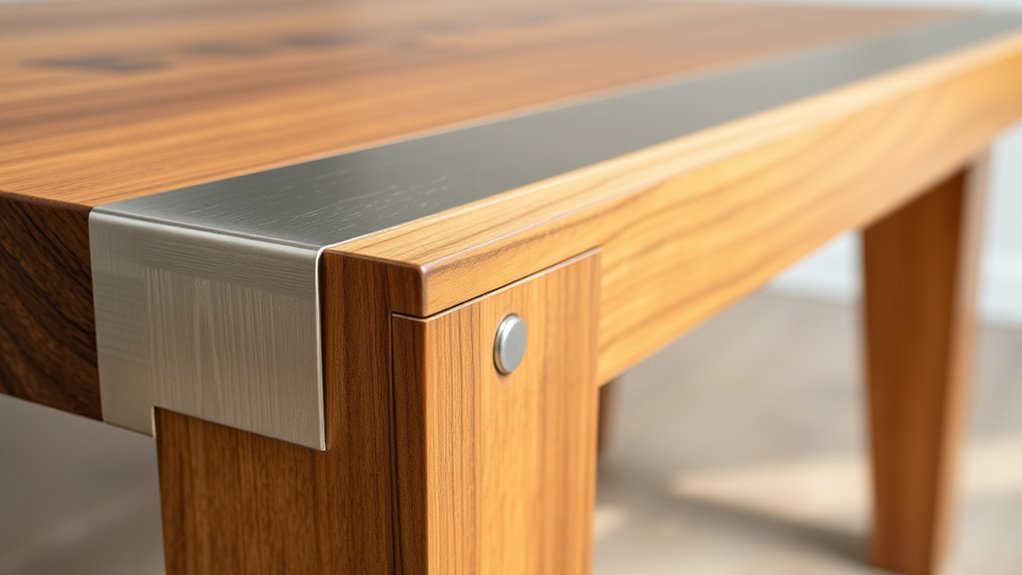
Combining metal and wood in your projects offers a range of tangible benefits that enhance both function and appearance. Metal provides superior strength and durability, supporting load-bearing features and reducing failure modes like warping or bending. Self Watering Plant Pots utilize a reservoir system that allows plants to absorb water as needed, highlighting how durable materials can contribute to long-lasting designs. Incorporating Material Compatibility considerations ensures that different materials work together effectively without degradation over time. Wood adds flexibility and natural shock absorption, balancing the rigidity of metal. This fusion results in longer-lasting, more resilient furniture and structures. Aesthetically, pairing warm, organic wood with sleek, industrial metal creates a striking contrast that adds visual interest. Patina finishes on metals like copper and brass age gracefully, complementing wood’s evolving texture. Versatile in design, this combination suits everything from furniture to architectural elements, allowing you to experiment with styles and finishes.
Safety and Practical Tips for Working Metal in Wood Shops
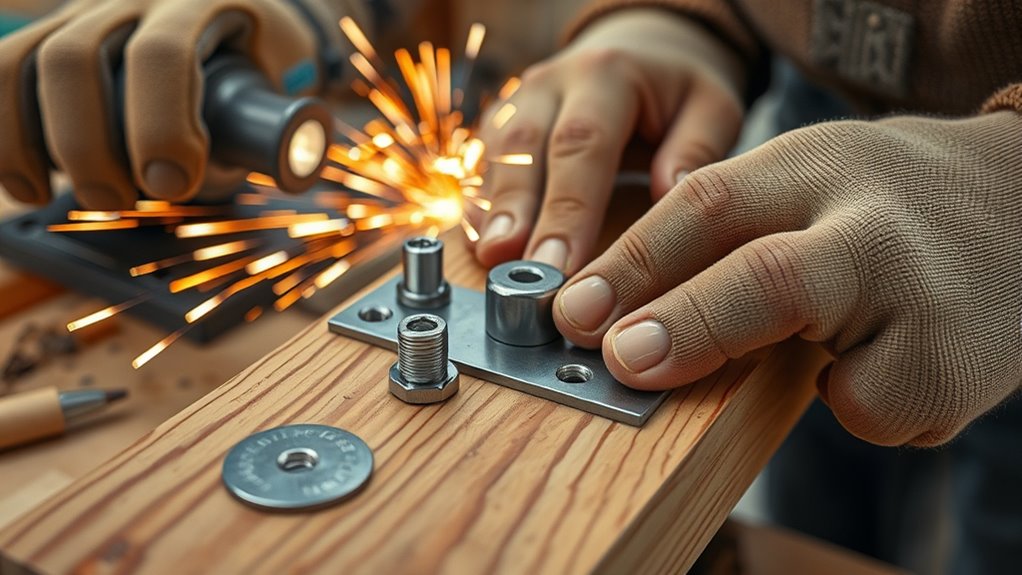
Working safely with metal in your wood shop requires careful preparation and vigilance.
First, inspect all wood for embedded metal like nails or screws that could cause kickback or damage tools. Remove metal fragments with the right tools, never by hand, to prevent injuries.
Inspect wood carefully for embedded nails or screws before working to prevent damage and injuries.
Make certain all machines have proper guards and are well-maintained before use to avoid accidents from flying debris. Keep your workspace clean by removing metal shavings and dust regularly.
Wear safety glasses to protect your eyes from metal chips, and use ear protection to guard against noise.
Handle metal debris with brushes or magnets, and dispose of scraps properly.
Always operate machinery with safety features engaged, turn off equipment before adjustments, and train yourself thoroughly to minimize risks. Proper tool maintenance ensures safety and prolongs equipment lifespan.
Being aware of the benefits of bees for pollination can also inspire careful handling of materials to maintain a safe environment for both humans and beneficial insects.
Additionally, understanding the properties of various metals can help you select appropriate tools and techniques for working with different materials safely.
Frequently Asked Questions
What Are the Best Types of Metal for Woodworking Projects?
When choosing the best metals for woodworking, consider aluminum for its lightweight ease and corrosion resistance, perfect for decorative or structural parts.
Brass and copper add aesthetic appeal with attractive patinas, great for accents or hardware.
Stainless steel offers durability and corrosion resistance for more functional elements.
Each metal’s properties influence your project’s strength, look, and maintenance, so pick based on your specific needs and desired finish.
How Do I Prevent Metal Corrosion in Woodworking Environments?
Think of your tools as soldiers on a mission—protect them from rust and corrosion. You prevent this by cleaning metal surfaces with mineral spirits, then wiping with acetone for a pristine finish.
Follow up with protective oils or paraffin sprays, and store tools in sealed, dry environments. Regular maintenance, like reapplying coatings and controlling humidity, keeps your tools battle-ready, ensuring they last through many woodworking campaigns.
Can I Use Standard Woodworking Adhesives With Metal Components?
You can’t rely on standard woodworking adhesives for metal components because they don’t bond well to non-porous, slick surfaces like metal.
Instead, you should use specialized adhesives like cyanoacrylate for small joints or epoxy for load-bearing parts.
Proper surface preparation, such as cleaning and roughening the metal, improves adhesion.
Keep in mind, weather and thermal changes can weaken bonds, so choose the right adhesive for your project’s conditions.
What Are the Optimal Storage Methods for Metal Tools in a Woodshop?
Think of your metal tools as precious gems that need a secure vault. You should use sturdy, lockable metal cabinets to safeguard against impacts and theft.
Optimize space with pegboards and shelves for easy access and visibility.
Keep tools dry with rust-resistant coatings and desiccants, and organize them by usage.
Clear labels and dedicated safety compartments ensure quick retrieval and safe handling, turning your shop into a well-guarded treasure chest.
How Do I Ensure Precise Measurements When Combining Metal and Wood?
To guarantee precise measurements when combining metal and wood, you should start by selecting the right measuring tools like combination squares, precision rulers, and calipers.
Always calibrate your tools regularly and use setup blocks for consistent spacing.
Take your time to double-check measurements, and use proper surface preparation and secure clamping to maintain accuracy during cutting and assembly.
This approach helps achieve clean, precise results in your project.
Conclusion
By blending bold metals with warm woods, you create captivating crafts that captivate and inspire. Mastering the methods, tools, and safety tips guarantees your projects are not only beautiful but built with confidence. Embrace the excitement of integrating metals, elevating your woodworking to new heights. With passion and precision, you’ll produce stunning, sturdy pieces that showcase your skill and spark your creative spirit. Let your craftsmanship shine, and turn ordinary materials into extraordinary masterpieces.
